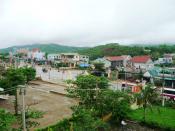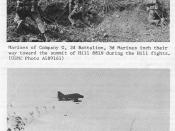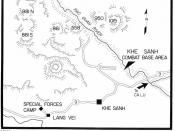The Siege at Khe Sanh was a culmination of political and tactical ingredients. Both
sides wanted this small plateau in the Northwest corner of the Quang Tri province. It
was the Northwestern most outpost south of the I Corps Tactical Zone. American
Marines, Army Artillery/Special Forces, Air Force Bombers and Fighters, and Naval
Fighters all played serious roles in the eventual victory at Khe Sanh in April of 1968.
South Vietnamese regular and irregular forces also played vital roles in the defense of
Khe Sanh. The real question is why did the American Forces led by General William
Westmoreland, find it necessary to hold that plateau in an almost wholly uninhabited
area? Why were the North Vietnamese, led by General Vo Ngyen Giap so determined to
occupy this piece of land? Why were they (NVA) unsuccessful, and why were we
victorious in the end? Within the limitations of ink and paper, I will probe and expose
answers to these questions, and attempt to paint a picture that is informative and realistic
into the seventy-seven day siege, that was won by a combined effort, and the discipline
and toughness of the men who fought and died there.
The Battle of Khe Sanh was not a "surprise" to either side. Both sides had set their
sights on the plateau for sometime before the siege of 1968. Gen.Westmoreland
described Khe Sanh's possibilities in 1964, "Khe Sanh could serve as a patrol base
blocking enemy infiltration from LAOS, a base for SOP (Special Operations) operations
to harass the enemy in LAOS, an airstrip for reconnaissance to survey the Ho Chi Minh
Trail: a Western anchor for the defenses south of the DMZ; and an eventual jumping-off
point for ground operations to cut the Ho Chi Minh Trail."(1) In April of 1967,
Westmoreland requested President Johnson's permission to enter LAOS and was denied.
There is no doubt that Khe Sanh was his ideal "thrust Point" to enter LAOS. Even
having been denied permission, he continued to build up the airbase at Khe Sanh so that
it could serve in the aforementioned capacity. The North Vietnamese suspected this, and
therefore knew that they had to take this land.
Although Westmoreland never gave up on the hopes of an invasion into LAOS, the
airbase had become a defensive strongpoint rather that a staging point in a matter of
months. This came due to the implementation of "the strong point obstacle system" A
DMZ barrier system devised by Defense Secretary Robert McNamara. Khe Sanh had
become the westernmost obstacle in this series of obstacles in the I-Corps Tactical Zone.
General Westmoreland knew that Khe Sanh was not only a defensive perimeter, and a
screen for NVA and Communist infiltration; but also served as a place where the enemy
could be fixed with Close Air Support, Indirect and Direct Fire, and Direct Fire from
machine guns. He could do this because the plateau was virtually uninhabited which
eased restrictions of fires for the area surrounding the Khe Sanh Airbase. He describes
this in his own works as, "Our defense of the area wound tie down large numbers of
North Vietnamese troops which otherwise could move against the vulnerable populated
area whose security was the heart of the Vietnamese Pacification Program. Our decision
to deny also held the prospect of causing the enemy to concentrate his force and thereby
provide us a singular opportunity to bring our firepower to bear on the enemy with
minimum restrictions. Had we withdrawn to fight the enemy's force of over two
divisions in the heavily populated coastal areas, the use of our firepower would have been
severely restricted because of our precautionary measure to avoid civilian casualties and
minimum damage to civilian property."(2) Early in the quote, General Westmoreland
alluded to "the Vietnamese Pacification Process". This was a constant theme to General
Westmoreland and always on his mind. This was also on the Communist's mind as well.
General Westmoreland felt strongly that this was the case and knew that Khe Sanh was
the gateway for the NVA to pour into I Corps, a gateway which led to some of the most
populated areas in the country. General Westmoreland clearly states, "It's seizure would
have created a serious threat to our forces defending the northern area and would have
cleared the way for the enemy's advance to Quang Tri City and the heavily populated
coastal area".(3)
General Giap knew that Khe Sanh was a key landmark for his tactical purposes, and
for his landmark for his tactical purposes, and for his government's political arms. With
the Khe Sanh, he could infiltrate South Vietnam unimpeded, taking away American
overwatch. With this avenue of approach, his people (communists) hoped to turn the
general civilian population against the Americans. Knowing that the Americans might be
planning on entering LAOS through the Khe Sanh, Giap ordered a Winter/Spring
campaign in the II and III Corps tactical zones. These served two purposes. First, to test
how the American's reaction to NVA infiltration and second, to serve as a diversion for
the actual infiltration of the Quang Tri province in the I Corps. This was the blueprint for
the TET Offensive.
The 3rd Marines arrived at the Khe Sanh on April 25 and 26, 1967. On April 27,
second artillery battery was dispatched there as well. Immediately upon arrival, the
Marines moved out to establish a perimeter on the outlying hills of the airbase. On May
3, 1967, the 3rd Marines had rid the three hills (861, 881N, 8881S) of all NVA. Shortly
thereafter, on May 11, 1967, the 1/26 Marines relieved the 3rd Marines (both battalions).
3/26 Marines arrived at the Khe Sanh on June 13, 1967, but were again moved to Con
Thien shortly afterwards only to eventually return in December. U.S. Army Special
Forces also set up a Forward Operating Base at Khe Sanh on Highway 9.
On January 20, 1968, the NVA began the siege of Khe Sanh. The first element in
contact was moving from Hill 881S to 881N about three miles Northwest of Khe Sanh
Combat Base (KSCB). 3rd PLT India Company came into heavy contact, the Company
Commander, Bill Dabney, remembered, "Lt. Brindley was killed as he reached the crest
(of the NVA held knoll), and with numerous other casualties, the 3rd Plt found itself
holding the piece of high ground with depleted ammunition stocks and ? a Lance
Corporal in command? an enemy skirmish line then charged up the rear slope to retake
the hill but was annihilated by a napalm drop so close to the marines that several had
their eyebrows singed."(4) This is a precursor to what the NVA would be repeatedly
subjected to in unprecedented amounts.
According to a captured NVA Lieutenant, the North Vietnamese plan of action was
revealed to his interrogators in depth, and in startling detail. What the members of 3rd
Plt. India Company had apparently encountered was a security perimrter on the
southeastern side of Hill 881N. The enemy's plan of attack according to Lieutenant Tonc
was as follows:
"Hill 881N is presently surrounded. There is a company of sappers deployed in the
general area of 881N. This sapper company will be used against Hill 861 (SE of 881N).
Once 881N has fallen, the general attack against the Khe Sanh Combat Base will
begin. This will consist of a reinforced regimental-sized force from direction of Lang
Hoal Tap by way of Hill 861, where they will link up with the occupying force there.
Once linked up, Khe Sanh Combat Base will begin receiving heavy artillery fire and
rockets from unknown positions, but from Northwesterly direction. When this occurs,
the first regiment will move to assault positions under cover of fire. One mortar platoon
on Northeast side of Hill 1015 will cover the Marine heavy weapons on Hill 950. One
mortar platoon will begin 82 mm mortar barrageon parked helicopters and airstrip. Each
of the Mortar Platoons has one 12.7 mm antiaircraft gun platoon in their adjacent areas to
cover them from counter air attack. If the first and second regiments are forced to
withdraw, they will lind up with the third regiment (position unknown) and commence
another attack on the Khe Sanh Combat Base. This will occur before TET."(5)
This is the blueprint of the NVA's plan to seize control of the plateau. Major General
Tommy Tompkins took Tonc's information as truth and later said of the intel, "I decided
that we would accept Tonc's information as valid since we had nothing to lose, and much
to gain."(6)
During these first days of siege, the City of Khe Sanh was overrun by the NVA. This
was a clear political target for the Communist regime. The siege was as much political as
it was tactical. As the capture Lieutenant alluded to in his interrogation, this was to go
down before TET. The result being, Khe Sanh becoming the ground headquarters for the
thrust Southward, and a deathblow comparable to that given to the French at Dien Bien
Phu. This was not to be.
In now disclosed Top Secret Documents written by General Westmoreland to
ADM Sharp (CINCPAC), he made it clear that he would support the Marines at Khe
Sanh in every was possible. As he stated on January 21, "I intend to do all possible to
bring to bear in the most efficient and coordinated way, all weapons that can support our
fight during the important period at hand."(7) He goes on in this document to outline his
plan for air assets and the delegation of air power within his scope of command.
This outlined immediately evolved into Operation Niagra, an air-strike counter-
offensive that virtually carpeted the entire Khe Sanh area. Photos of the landscape during
Operation Niagra show am almost completely surrounded airbase with nothing but
blackened landscape surrounding to aistrip for two miles, save the outposts around the
airbase.
Operation Niagra kicked off on January 21 and ended on March 31, 1968. This was
for all intents and purposes, "the life support system" of the Khe Sanh without the air
support, the area would have undoubtedly fallen to the North Vietnamese. The United
States Headquarter Military Assistance Command, Vietnam (MACV) reported in the
official summary of the siege as:
Friendly Positions -
Area ? 4.8 km
Enemy delivered fires ? 99.25 tons
Friendly Forces ? 6085
Enemy Positions ?
Area ? 564 km
Friendly Delivered Fires ? 99,600 tons
Enemy Forces ?
15 Jan 68 ? 20,000
31 Mar 68 ? 9,100
Avg. ?15,100 (8)
The losses inflicted on the enemy were estimated by Headquarter of MACV as
being, "between 49% and 65% of the personnel committed to the Khe Sanh Operation
including replacements." (9)
This estimate is indicative to the effectiveness of all support assets that were
committed to place direct and indirect fires to the areas surrounding the airbase and it's
outposts.
Another "all-important" asset that forces defending Khe Sanh had, that many
units in the midst of TET did not, was an undying and overwhelming supply line.
Supplies were dropped for the Marines that sustained them through the course of the
siege. Eric Hammell, author of Khe Sanh, Siege in the Clouds wrote, "There would be no
"set-piece" strategy ? without one of the biggest aerial re-supply efforts in history. The
effort was enormous."(10) The importance of the KSCB, and the logistical effort to
support it, is reiterated by Major Tom Cook 26th Marines Assistant Logistics Officer,
"Every day around 1800, I called Dong Ha on the land line and reported a long, long list
of numbers?when the report was received in Dong Ha, it was immediately forwarded to
Saigon, to MACV Headquarters. From there, it was dispatched directly to the White
House so that President Johnson and his staff could look at it, to make sure that Khe Sanh
was not going to fall."(11) This is evidence to the complete and total commitment to the
mission at Khe Sanh.
The siege at Khe Sanh ended in April 1968 after the marines made link up with
elements of the 7th Calvary Division during Operation PEGASUS. Although the KSCB
was ordered to be abandoned shortly afterwards, on June 12, 1968,it remains one of the
most efficient and concerted efforts during the Vietnam War. final victory was American
at the end of the siege. The Communist effort was heavy in manpower, and the NVA
determination was persistant, but even with smaller numbers the airial assets, and
unending barrages of direct and indirect fires proved too much for the demoralized
enemy. The NVA would not realize another Dien Bien Phu repeated at Khe Sanh.
Works Cited
Shore Moyer S. The Battle for Khe Sanh. Prologue by L.F. Chapman, Forward by W.C, Westmoreland, Preface by R.E. Cushman. Washington: Government Printing Office, 1968.
(2) p.vii, (3) p. vi
Hammel, Eric. Khe Sanh, Siege in the Clouds, An Oral History. New York, NY: Crown, 1989.
(4) p.52, (5) pp.57-58, (6) p.58, (10) p.261, (11) pp.261-252
Westmoreland, W.C. to ADM Sharp. Declassified Documents. 21 January, 1968.
http://members.easyspace.com/airdrop/start/w012168.jpg
(7) p.1
Headquarters, Military Assistance Command, Vietnam. An Analysis of the Khe Sanh Battle. 5 April 1968. http://members.easyspace.com/airdrop/analogy/w040566.jpg
(8) p.2, (9) p.3
Marino, James L. "Strategic Crossroads at Khe Sanh". Taken from Vietnam (1999)
www.thehistorynet.com/vietnam/articles/1999/1299_texthtm.
(1) p.1



Very nice
The essay was good, I think it was a bit vague in the beginning. You could have added some.."pizazz" to it by going deeper into detail when you begin to explain things. Other than that, the general thoughts and ideas in the essay were great, just try to rethink some of the sentences and paragraph beginnings/endings.
4 out of 10 people found this comment useful.